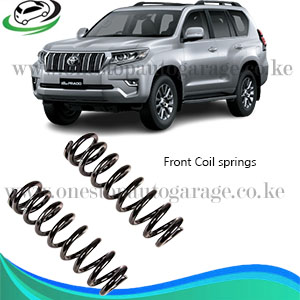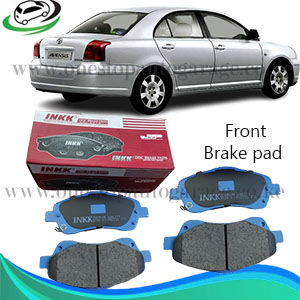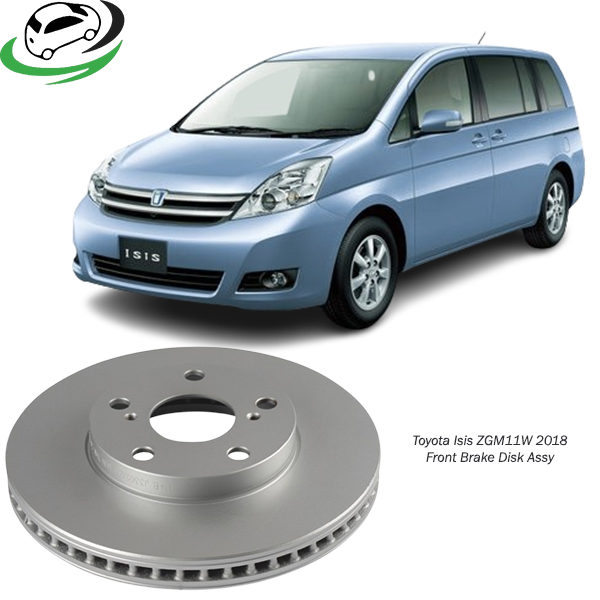-17%
Get Toyota Isis ZGM11W 2018 Front Brake Disk Assy 43512-44010 in Kenya
The front brake disc assembly is a critical component of a vehicle’s braking system, playing a central role in ensuring safety and control during driving. The braking system converts the vehicle’s kinetic energy into thermal energy, allowing the vehicle to slow down or come to a complete stop. In this comprehensive guide, we will explore the components, functions, benefits, maintenance, and signs of wear associated with the front brake disc assembly, along with some tips on how to extend its life.
1. Understanding the Front Brake Disc Assembly
The front brake disc assembly consists of several key components that work together to provide effective braking. The primary parts include:
- Brake Disc (Rotor): The brake disc, commonly referred to as the rotor, is a round, flat piece of metal that rotates with the wheel. When the brake is applied, the brake pads clamp onto the rotor, creating friction that slows down the wheel.
- Brake Caliper: The brake caliper houses the brake pads and is responsible for pressing them against the rotor when the brake pedal is engaged. Calipers are either floating or fixed, with each design offering unique performance characteristics.
- Brake Pads: These are components with friction material that clamp onto the rotor. When the driver applies the brakes, the pads are pressed against the rotor, creating the friction needed to stop the vehicle.
- Caliper Bracket: This component holds the caliper in place and supports its movement, ensuring that the brake pads are correctly aligned with the rotor.
Together, these parts create the front brake disc assembly, which provides a reliable, high-performance braking solution.
2. How the Front Brake Disc Assembly Works
The braking process is initiated when the driver presses the brake pedal, activating the hydraulic brake fluid. This fluid flows from the master cylinder to the brake caliper, pushing the pistons in the caliper against the brake pads. The pads then make contact with the rotor, generating friction, which gradually reduces the wheel’s rotational speed and eventually stops it.
The friction between the brake pads and the rotor converts the kinetic energy of the moving vehicle into heat. Modern rotors are designed with special materials and vented designs to dissipate heat effectively, preventing overheating and maintaining braking efficiency. This entire process occurs almost instantaneously, allowing the driver to control and stop the vehicle smoothly.
3. Materials Used in Front Brake Discs
Brake discs are typically made from materials chosen for their durability, heat resistance, and ability to withstand extreme friction. Some common materials include:
- Cast Iron: Traditional brake rotors are made of cast iron due to its durability and ability to absorb heat.
- Carbon Composite: Carbon composites are common in high-performance and racing applications, as they offer superior heat resistance and lightweight properties.
- Ceramic Composite: Used in some high-end vehicles, ceramic composite rotors provide excellent braking performance and last longer than traditional rotors. They are also more resistant to wear and produce less brake dust.
4. Benefits of the Front Brake Disc Assembly
The front brake disc assembly offers several advantages over other braking systems, including:
- Superior Stopping Power: Disc brakes are more effective at stopping the vehicle than drum brakes, especially under high-speed or heavy-load conditions. This is due to the larger surface area of the rotor, which allows for more friction.
- Efficient Heat Dissipation: Modern brake discs are often vented or drilled to improve air circulation and heat dissipation. This feature prevents overheating, which is crucial for maintaining braking performance.
- Resistance to Fading: Brake fade occurs when brakes lose effectiveness due to heat buildup. The vented design of brake discs reduces fade, ensuring consistent performance even during extended braking.
- Durability and Longevity: High-quality brake discs are made from durable materials and are less susceptible to wear than drum brakes. As a result, they typically have a longer lifespan and require less frequent replacement.
- Improved Control: Front disc brakes provide smoother and more consistent braking, which translates to better handling and control for the driver.
5. Maintenance and Care of Front Brake Discs
Regular maintenance is essential to ensure that the front brake disc assembly performs optimally. Here are some key maintenance tasks:
- Regular Inspection: Routine inspections help identify signs of wear, such as uneven rotor surfaces, cracks, or excessive thinning. It’s recommended to have brake components inspected every 10,000 miles or as recommended by the manufacturer.
- Check Brake Pads: Worn brake pads can damage the rotor if not replaced in time. Replacing brake pads before they reach critical wear levels prevents rotor damage and ensures braking efficiency.
- Fluid Replacement: Brake fluid should be changed every 1-2 years, as old fluid can absorb moisture, leading to corrosion and reduced braking power.
- Cleaning and Lubrication: Over time, dirt and brake dust can accumulate on the caliper and pads. Cleaning the assembly and applying a high-temperature lubricant to the sliding parts ensures smooth operation.
- Rotor Resurfacing or Replacement: If the rotor shows signs of wear but is not severely damaged, resurfacing (machining) it to restore a flat surface may be an option. However, if the rotor is too thin or damaged, it should be replaced.
6. Signs of Wear in the Front Brake Disc Assembly
Recognizing the symptoms of a failing front brake disc assembly can prevent further damage and ensure vehicle safety. Common signs include:
- Squeaking or Squealing Sounds: High-pitched sounds when braking often indicate worn brake pads or rotor issues.
- Vibrations or Pulsations: A vibrating brake pedal or steering wheel, especially when braking, may indicate a warped rotor.
- Grinding Noises: Grinding sounds occur when brake pads are excessively worn, allowing the metal backing plate to come into contact with the rotor.
- Increased Stopping Distance: If it takes longer for the vehicle to come to a stop, the brake discs or pads may be worn.
- Visible Grooves or Scoring: Deep grooves on the rotor surface signal wear and may reduce braking effectiveness.
If any of these symptoms are noticed, it’s essential to inspect the brake assembly immediately and replace or repair any damaged components.
7. Extending the Life of the Front Brake Disc Assembly
To maximize the lifespan of the front brake disc assembly, consider these tips:
- Drive Smoothly: Aggressive braking generates excess heat, which can lead to rotor warping. Try to anticipate stops and apply brakes gradually.
- Use High-Quality Components: Investing in high-quality brake pads and rotors can reduce wear and provide better performance.
- Avoid Riding the Brakes: Keeping your foot on the brake pedal while driving, especially downhill, can cause overheating. Instead, use engine braking when appropriate.
- Install Heat-Resistant Rotors: For high-performance or heavy-duty applications, heat-resistant rotors reduce wear due to high temperatures.
- Replace Pads Before They Are Fully Worn: Waiting too long to replace brake pads can cause damage to the rotors and increase overall wear.
8. Advancements in Brake Disc Technology
Modern brake disc technology has introduced innovations that improve braking performance, including:
- Drilled and Slotted Rotors: Designed to improve cooling and reduce brake fade, these rotors are commonly used in performance vehicles.
- Coated Rotors: Some rotors come with anti-corrosion coatings that protect against rust and wear.
- Two-Piece Rotors: Found in high-performance vehicles, two-piece rotors have a separate hub and rotor ring, allowing for better heat management and lighter weight.
9. The Role of the Front Brake Disc Assembly in Vehicle Safety
The front brake disc assembly is one of the most critical safety components in a vehicle. It allows drivers to maintain control in various driving conditions, ensuring that they can stop effectively when necessary. By reducing stopping distance and enhancing brake response, a well-maintained front brake disc assembly helps prevent accidents and improves overall driving confidence.
10. Conclusion
The front brake disc assembly is a vital component of a vehicle’s braking system, providing reliable stopping power and safety. With regular maintenance and timely replacement of worn parts, the front brake disc assembly can perform optimally, ensuring safe and controlled braking. As technology continues to evolve, brake disc assemblies are becoming more efficient, durable, and specialized for different driving needs.
Follow us on Facebook for more parts.



